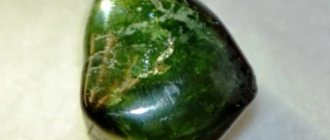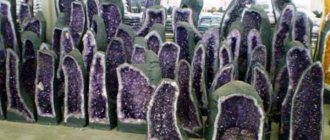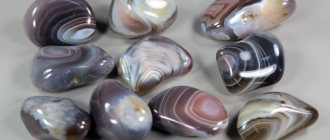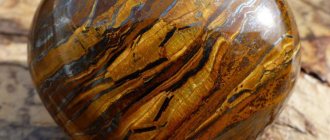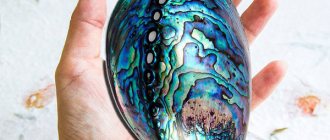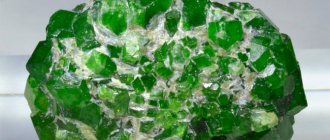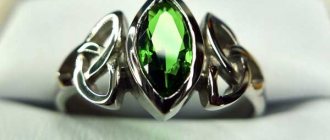Story
The properties and characteristics of the mineral have been known as magical for thousands of years. He was respected in Ancient Egypt and throughout the Slavic expanses. Therefore, possession of the stone was the privilege of priests or rulers. Until the beginning of the twentieth century, ordinary people considered the mineral “devilish” and tried to stay away from it. This reputation and name are due to the similarity with cat's eyes - the cat, as is known, accompanies witches, sorcerers, and is considered connected with the other world.
The cat's eye stone was not used for mundane purposes - only as a magical attribute. Its price was prohibitive.
The 19th century was a turning point. The British high society set an example. Initially, a stone weighing 300 carats, that is, 60 grams, was presented to Queen Victoria (now it is kept in the treasury of the British Crown). Prince Arthur then presented the ring with the stone to the bride. After this, the value of the gem was appreciated by the nobility - everyone wanted to have the same one.
The ring with a cat's eye was the talisman of the Russian writer Ivan Bunin.
Cat magic of gems
In ancient times, “eye-stones” had meaning for magicians, astrologers and other initiates. The gem was used in predicting the future.
The magic of the cat's eye will help a teenager survive a difficult period of growing up, and it will be easier for parents to cope with the “concerts and quests” that rebellious teenagers can organize. Earrings for a girl, a bracelet or pendant for a boy - and the atmosphere in the family will improve.
Cat's eye stones
The magic stone will protect the peace of mind in times of crisis and reduce nervous excitement.
Each gem with a cat's eye effect is a talisman of good luck for the owner.
Important: all magical properties are inherent only in real, natural “cat’s eyes”.
A cat's eye is an excellent amulet. Protection from the evil eye and astral attacks is included in the professional responsibilities of the stone.
The magical properties of the stone will be assistants to creative people - musicians, poets, artists, performers. The eloquence and charm of the owner of a wonderful stone will reveal itself and reach heights.
Mysticism: there is a belief that a gem with an iridescent effect given to an enemy will end hostility. Try giving your enemy a big-eyed stone. If you become friends and the hostility stops, write to us. Let us prove the veracity of the belief.
Physical properties
Cat's eye is not a type of mineral, but the name of an optical effect that looks like a narrow luminous strip. It appears as a result of processing different gems and moves when the stone is rotated.
Description of the stone:
- hardness on the Mohs scale – 8.5 out of 10 possible;
- iridescence - gray or golden-green reflections, reminiscent of the iris of a cat's eye, created by impurities;
- shape - the mineral is always processed as a cabochon;
- specimens of any color have a golden sheen.
By origin it can be natural or artificial, obtained by combining borosilicate glass fibers and barium titanium.
Varieties
The effect was first obtained by processing yellow-green chrysoberyl, which became the classic embodiment of the variety. The similarity to a cat's eye in color and glow also played a role. The signature highlight is created by rutile needle inclusions.
The stone can be golden-green, reddish, amber.
If the name of the stone is not specified in the variety, then it means chrysoberyl. The following stones also have this effect:
- quartz – usually green;
- moonstone - white, blue, blue.
Precious rubies, sapphires, opals, and topazes are processed using the cat's eye technique. The type of stone determines how much a particular cat's eye will cost.
Magic properties
The magical potential of a cat's eye is described in ancient legends. It is valued by magicians and sorcerers. Ancient Hindus used it to see into the future or understand the language of animals. There is evidence that the magic stone warded death away from its owner. It was preserved by the nobles who left Russia after the revolution, which helped them survive the sorrows of emigration.
We recommend reading: Lapis lazuli - the magical properties of the sky stone
The mineral affects the owner and his environment:
- Wards off troubles, protects from the evil eye, enemies, damage. Signals danger by becoming heavier when touched to the skin.
- Makes the owner charismatic, enhances his charm, which is noticed by others. It is worth purchasing a product with a cat's eye for a timid person. He will become decisive, authoritative, and achieve goals that seemed unattainable.
- Increases sensitivity, especially to signs sent from above. Strengthens the aura, is able to open the “third eye”. Teaches you to trust your inner voice and understand people’s secret plans.
- It is important for building relationships in all areas. Strengthens friendship, evokes reciprocal love, helps maintain marital fidelity. The owner of the stone does not know the pangs of jealousy. He is an optimist in life, condescending towards the shortcomings of his neighbors. To make an enemy become a friend, you should give him a cat's eye.
- The cat's eye stone has the ability to activate talents dormant in the owner, to stimulate him to concentrate on the main thing, to work on himself. The owner of the gem looks at life philosophically, without getting hung up on trifles.
- Attracts wealth. Cat's eye jewelry is an attribute of financial tycoons and aristocrats. Stones bring stable success, including through gambling.
With him, a man will acquire strength of character and courage, a woman will gain grace and charm.
The cat's eye is energetically receptive, so the owner must think positively. Otherwise, the magical properties of the stone will attract problems.
Tsimofan, who's next?
The ethics of jewelers says: only chrysoberyl has the right to be briefly called “cat’s eye”. Other gems with this optical effect should specify the type of stone (for example, “cat's eye quartz”).
Chrysoberyl
Not only the rare tsimofan (cymofan) - a gem with a cat's eye effect. In principle, stones with an amazing effect are rarely found. That's why they are quite expensive.
There are many varieties of minerals with iridescence.
Expensive and cheap (without the cat's eye property) stones soar in price as soon as they look at the world through the eyes of a lazy cat.
Types of such gems:
- quartz;
- zircon;
- emerald;
- nephritis;
- apatite;
- andalusite;
- goethite;
- moonstone (adularia).
The list goes on. The miracle of the amazing cat's pupil is that it can appear in many gems - or it may not appear.
Such colorful cat eyes
It is important that the gem is treated as a cabochon. Then the serious, slightly incredulous gaze of the gem will look at you. But in some raw crystals, when you turn it in your hand, the iridescence of a cat's eye appears.
- Tsimofan. From the noble chrysoberyl family. The color of the mineral is usually green: whitish-green, golden-green, emerald green, greenish-brown. There are yellow and blue cymophanes.
- Quartz cat's eye . Colors grey, white, green, yellow.
- Tourmaline cat's eye . Colors pink, green, blue-green, brown to black. A purple stone with a red tint is good.
- Moonstone, adularia . In addition to the cat's eye effect, it has a special glow and shimmer. The combination of two optical effects gives adularia the love of everyone who sees the gem. The color of moonlight, mysterious, blue-white, unclear, enchanting...
- Prehnite cat's eye . A mineral little known to stone lovers. And gemological historians know that prehnite is the first mineral named after a man, Captain van Pren. They brought the pebble from the distant Cape of Good Hope.
The color of the stone and its mystical properties
You can buy jewelry with an iridescent effect, whose magical properties will help in your work and career.
Jewelry with cat's eye
Here's what esotericists say about gems of different colors:
- White gem . It's for women. Protects against gynecological diseases. It will help mommy not to go crazy when the child is 10-20 minutes late from school or from a walk. It will help the housewife not to find problems on her own head.
- Yellow gem with an iridescent effect . This stone will help priests, teachers, psychologists - those who need the trust and respect of their audience.
- Iridescent pink mineral . The stone is “hermaphrodite” in its energy. It is equally good for men and women. Its main property is to harmonize the owner’s emotions. Extinguishes the aggression of the ardent owner of the jewelry. For those who are too timid, the peephole will give them a bit of courage and determination. If your work is related to advertising or trade, this is your gem.
- Blue cat eye. May be useful for psychics and magicians. The blue eye of a predator will help develop intuition, clairvoyance, and attention to details that are usually not noticed by anyone. You don’t work, you’re just a happy romantic and a dreamer (if there are such people left on the planet) - a gem for you.
- Grape-green gem with an iridescent effect . A real money magnet. It will provide the owner of the stone with “luck” - good luck in financial matters and drawing up profitable contracts. “Owners of factories, newspapers, ships” - this eye will see your profit everywhere.
- Blue or white-blue adularia can harm “two-faced” people, those who are “both ours and yours.” The pebble also doesn’t like playing with the law. Purity of thoughts and deeds is the motto of the gem.
We recommend: FIRE OPAL - incredible colors of sunstone
Important: the value of a stone with iridescence is higher, the stronger and more clearly the optical effect is manifested.
Therapeutic effect
The strong magical abilities of the mineral are complemented by healing ones.
- Vision. The stone, whose name speaks for itself, comprehensively solves eye problems: the green bracelet cures diseases and sharpens the ability to see in the dark like a cat. Eye fatigue will go away if you apply a stone of suitable dimensions to them for a few minutes.
- Heart, blood vessels. A ring on the index finger eliminates headaches and strengthens blood vessels.
- Pressure. For hypertension, you need an instance of the yellow scale, hypotension requires blue or green stones.
- Breath. Inhibits the development of the disease, helps cure pneumonia, sore throat, bronchial asthma, and other respiratory tract ailments. Makes breathing easier, helping to clear the lungs faster. The effect is enhanced by a pendant or beads around the neck.
- Injuries, fractures. Wounds, internal inflammation, and other tissue damage will heal faster with it.
- Nervous system. The natural mineral will ease neuroses, depression, reduce aggressiveness, and bring peace and harmony to the soul. It’s enough just to sort through the “big-eyed” rosary.
- Digestion. Cat's eye tones, activates the system, can act as a laxative, and helps with indigestion.
Minerals treat blood diseases, improve the functioning of internal organs, and strengthen the immune system. The healing properties of cat's eye have been confirmed experimentally.
We recommend reading: Rose-colored opal - a talisman of hope and love
Medicinal properties
It is worth noting that in folk medicine and lithotherapy the stone is treated with great respect. It is believed to have healing properties. The more a gem resembles a cat’s real eye and the more pronounced its glare, the greater the healing effect it has.
The stone is used to combat the following ailments:
- To relieve joint pain due to bruises and other diseases.
- To normalize the nervous system.
- To improve the functioning of the nervous system.
- For lung diseases.
In addition, chrysoberyl is used to treat diseases of the liver, kidneys, digestive tract, pancreas, and eyes.
Talismans and amulets
The cat's eye stone has been considered magically powerful for centuries and was worn as an amulet that protects against dark forces. Not much has changed today.
This is a talisman for diplomats, teachers, and representatives of creative professions. The mineral will give inspiration, reveal talent, add charm and eloquence.
The magic of the stone smoothes out extremes in the owner’s character. It makes the aggressive one softer, the soft one more decisive.
- Girls looking for love for life wear a pendant, earrings or ring.
- Green or yellow copies are a money talisman, stored next to banknotes. Jewelry with a mineral is worn by ladies who want to get an increase in salary or a higher position. For men, a crystal in their pocket or a ring is enough.
- Blue quartz protects against envy, jealousy, anger, and aggression.
- Pendants are worn by children to prevent sore throats.
- It is believed that you can save a person from death by giving him a necklace or rosary.
- The cat stone is placed in a place of honor in the house to strengthen family ties.
- The image of a reserved business person is created by jewelry with stones of the same color. Multi-colored ones are worth buying for people who position themselves as free from conventions.
- The cameo stone neutralizes the evil eye best.
For the power of the stone to work, you need to know how to wear it correctly:
- When decorating, it should be in contact with the skin. Any frame will do.
- Other gems for decoration are excluded. The cat's eye is an egoist who does not tolerate neighbors. Like a cat that walks by itself.
The best talisman or amulet is a ring. In it, the cat's eye exhibits magical properties to the maximum.
Colors by profession
It is believed that the “professional” orientation of a stone depends on what color it is.
Yellow
Forces people to listen to the owner’s opinion, instills confidence in him. It may be suitable for anyone who influences people verbally - priests, scientists, teachers. Worn as a pendant or ring.
Golden brown
Talisman of people in power. On a subconscious level, the properties of the cat's eye stone will add self-confidence to the owner-manager and the respect of his subordinates. Any highly visible decoration makes the maximum effect.
Golden green
A symbol of financial success, an attribute of business people and everyone who wants to get money. Rosary beads or signets will attract profitable deals, money clients, and good luck in the broad sense of the word. The stone will spur you to move forward, instill confidence, and make you achieve your goal.
Dark green
Assistant to performers or those engaged in physical labor. The mineral will help you not to be nervous and concentrate on work. A pendant on top of clothes or a bracelet will eliminate envy and protect you from damage or the evil eye.
Varieties and colors
The diverse color palette makes the influence of the talisman on the aura of its owner different:
- Gold and brown tint (“tiger”) is a stone of power; it is chosen by managers, politicians, and businessmen who are responsible for making decisions. The crystal helps them gain confidence in their abilities and strengthen their authority, and gain support. In this case, the stone is worn so that it is better visible, for example, in the form of a ring or on the chest.
- Yellow cat's eye is one of its most common varieties. Mineral of mentors, teachers, clergy. Its power lies in enhancing the gift of persuasion. In the form of an amulet, a pendant or ring with a yellow cat's eye is preferable.
- A dark green crystal will support people engaged in heavy physical work, reduce stress, increase concentration, and restore emotional balance. Magical properties protect against the evil eye, damage and the machinations of energy vampires.
- The golden-green shade is closest to the color of a cat's pupil and is rightfully considered a magnet for money. This is a mineral for financiers, businessmen, analysts, and economists dealing with large cash flows. Will help you conclude profitable deals and minimize the risk of losing money. Effective in the form of a rosary or bracelet.
The grinding should be filigree so that the axis of the strip is located in the middle, imitating the pupil of a cat. The iridescent hue appears due to the reflection of light from air bubbles enclosed in the mineral.
How to distinguish a fake?
The high cost of natural stone provokes the production of fakes. Determining the origin is easy:
- Strength. This mineral is inferior in this regard to ruby, sapphire and diamond. Chrysoberyl scratches glass, and only these stones can damage it.
- Luminosity. In the dark, the natural mineral glows like a cat's eye.
- Friction. A natural gem rubbed with a cloth in the dark sparkles more, but the fake does not change.
- Gleam. The real mineral is brown or green, the fake mineral has any color, including pink or blue.
- Blik. Natural has a straight line. Zigzag or roundness means glass.
We recommend reading: Prehnite is a powerful stone that predicts the future
Under normal lighting, fake stones are brighter and more impressive than natural ones.
Video: How to distinguish a cat's eye from a fake?
Color features
A light green cat's eye adds good luck to its owner and makes a person more purposeful. It is difficult to say whether this is true or not, but since ancient times the stone has been considered incredibly strong. It is recommended to be worn by those people whose activities are related to finance. Gems in rosaries or signets have the most effective effect.
But dark green chrysoberyl has very strong protective properties. For the greatest manifestation of the qualities of a gem, it must be worn so that it is clearly visible. Therefore, bracelets or pendants are very good in this sense. Such amulets are suitable for people of all professions, especially those whose work involves increased risk.
Artificial cat eye
The catsite material (that is, a segment of a cat's eye) and the production method were developed in the USA. The cat's eye mineral is colored fiber optic glass. Small specimens are transparent, large ones are cloudy.
The main supplier of artificial rich green or yellow-brown stones is China. Their red price is $7-25.
The price of a natural one is comparable to a diamond, sometimes exceeding it. Depends on the mass, the degree of purity of the material and the brightness of the glare. For example, cut stone inserts weighing 3–5 carats have a price of $30–100 per carat.
Finding in nature, deposit
Chrysoberyl is found in foreign countries - in Brazil, on the island of Madagascar. In Russia, this mineral is observed on the Kola Peninsula, South Karelia and Siberia. The jewelry variety of chrysoberyl, alexandrite, is mined in Russia at the Malyshevskoye deposit.
Currently, new mineral deposits are being developed. This is due to the growing popularity of the stone due to its magical, healing properties.
Product care
Cat's eye is durable and not afraid of mechanical damage. But in order for the magical properties and aesthetic appeal to be preserved, care is needed.
The mineral does not like temperature changes, cosmetics, household chemicals, or abrasives. It may scratch the “neighbors” in the box, so it is stored separately.
Stones are washed with warm water and soap and a cotton swab. To avoid losing their shine, they are not dried, but wiped immediately with a soft cloth.
Application and care
The most ancient use for the cat's eye is amulets and talismans. It is not without reason that the stone has been used by magicians for centuries. But even if you are not a shaman, witch or sorcerer, the stone will help you protect yourself from dark energy, achieve happiness and success in life. Most of all, of course, it is suitable for women. And wearing such a talisman is worth it in plain sight.
The cat's eye is used in jewelry, decorative crafts and, of course, as a talisman.
Another area where stone is successfully used is the creation of jewelry. The best options include:
- Rings and rings with a cat's eye. In esotericism, it is believed that the talisman will absorb all the negative energy directed at the owner. Many people recommend wearing this ring as an engagement ring.
- A pendant with a gem will be a good decoration for a woman. It will help the hostess become more self-confident, make her attractive, and give her a special charm. Another interesting feature is that the cat’s eye creates an invisible psychological boundary between the wearer and the outside world. Only those people with whom the woman herself wants to communicate will be able to cross it.
- Bracelets with a cat's eye also look great. Like all other jewelry with a gem, they are worn in plain sight to enhance the protective effect of the mineral.
But not only jewelry is made from cat's eyes. This beautiful gem is an excellent raw material for various souvenirs. They make boxes, candlesticks, and rosaries from it. Larger products, such as facing tiles or figurines, are carved from synthetic types of stone. Outwardly, they are almost indistinguishable from natural ones.
In order for your jewelry to last as long as possible, you need to remember how to properly store a cat's eye stone. Its properties are such that it is quite durable, you don’t have to be afraid that the gem will break or be scratched. However, crystals still do not forgive neglect. What is the first thing the mineral doesn’t like?
- Abrasive cleaning products.
- Cosmetics.
- Household chemicals.
- Temperature changes.
- Close proximity to other stones - a cat's eye can push or scratch them.
From time to time, the stone should be washed without using aggressive household chemicals - only with warm soapy water and a soft cloth or brush. To prevent the mineral from losing its shine, after cleaning it is not left to dry, but wiped dry.
Cat's Eye and Zodiac
Astrologers consider the gem to be universal, suitable according to the horoscope for any sign of the Zodiac circle. The main thing is that the owner loves him.
- Its meaning is vitally important for Pisces, Cancers, Scorpios - the stone will manifest itself to the maximum as a protector. It will give inspiration to creative people.
- It is advisable for Cancers and Scorpios to wear a cat's eye without other stones.
- In addition to these favorites, the mineral will appreciate the zodiac sign Libra. On a lady, it will become a magnet for men, emphasizing the natural grace of the hostess.
- Among those to whom this stone is suitable according to their zodiac sign are Virgo and Gemini. It is useful for them to have a cat's eye as a talisman in any endeavor. But it must be alone, even in decoration, without other gems.
- Those for whom the stone is suitable according to their horoscope include Capricorns, Aries and Sagittarius. The stone will help in any combination.
- The compatibility of the cat's eye with Aquarius is controversial. Some believe that it will drain energy from the owner without compensating for losses. Others are sure that it is just as good for this sign as it is for Taurus.
A real cat eye isn't cheap. But if you are lucky enough to find a suitable copy, do not miss the moment. Whatever the cost, the help of a powerful stone will pay off handsomely. It will delight you during the day and delight you with its mysterious sparkle in the dark.
Paleoentomologists doubt the uniqueness of trilobite eyes
Rice.
1. a
,
b
,
c
- head, eyes and individual facets of a fossil centipede mosquito;
d
and
e
are photographs of the facets and calcite lens of a fossil midge mosquito taken using a scanning microscope;
f
— facets of a modern centipede mosquito
Nephrotoma suturalis
, taken using a scanning microscope;
g
and
h
- histological sections of the cornea of
N. suturalis
, on which chitinous lenses are visible.
PFW—pigment-containing facet walls, PG—pigment granules. Lengths of scale segments: e
,
h
- 10 µm,
d
,
f
- 30 µm,
c
,
g
- 50 µm,
b
- 300 µm,
a
- 2 mm.
Image from the discussed article in Nature
Danish and Swedish paleontologists studied the prints of Eocene centipede mosquitoes and discovered corneal lenses made of calcite in their compound eyes. However, during life, these insects undoubtedly possessed chitinous lenses. It follows that calcite replaced chitin during fossilization. According to the assumption of the authors of an article published in the journal Nature
, the same post-mortem mineralization can also explain the presence of calcite lenses in the eyes of trilobites, which is considered their unique feature. In addition, scientists identified traces of eumelanin in the partitions between the facets of fossil mosquitoes, and then found this pigment in their living relatives. Previously it was believed that melanin pigments were absent in the eyes of arthropods.
In the book of the British paleontologist Richard Fortey “Trilobites”, published several years ago in Russian, there is a chapter called “Crystal Eyes”. In it, Forti draws very poetic parallels between the polished floor slabs of Italian cathedrals, the columns of ancient amphitheaters, Iceland spar crystals and... the eyes of trilobites. Indeed, according to the generally accepted view, trilobite eye lenses were made from the same material as all of the above - calcite (CaCO3). Therefore, we can say that trilobites had a “stone” gaze in the literal sense of the word - they looked at the world through mineral crystals. “And this alone sets them apart from the entire animal kingdom.”
“Forti concludes, and most paleontologists and textbook authors would subscribe to his words.
Nowadays, only brittle stars, relatives of starfish and other echinoderms, use calcite crystals for vision. But brittle stars do not have eyes as such—calcite crystals are scattered over the entire surface of their body, focusing light rays onto underlying tissues. This primitive system allows brittle stars to distinguish light from shadow and determine the location of the light source, but nothing more. Lenses made of aragonite (this mineral differs from calcite in the structure of the crystal lattice) were recently found in the shell of chiton mollusks, but their vision is also far from perfect (The mineral eyes of chiton mollusks are able to distinguish the shape of an object, “Elements”, November 23, 2015). However, arthropods, including arachnids, crustaceans and insects, which need to perceive more complex visual stimuli, do so with the help of lenses made from chitin, a nitrogen-containing polysaccharide that is part of their integument. That is, in terms of their chemical composition, the corneal lenses of a dragonfly or shrimp are almost identical to their legs and whiskers.
Trilobites are the oldest known arthropods, appearing almost at the very beginning of the Cambrian, about 520 million years ago. But anatomically, their compound eyes are not fundamentally different from the eyes of living arthropods. They also consist of many structural elements - ommatidia, each of which is externally equipped with a hexagonal or round light-refracting element (corneal lens). Considering the similarities in other characteristics, according to the logic of things, these lenses in trilobites should be chitinous, like in all their relatives. It would be strange to find a smartphone on the street of an absolutely standard design, but with a screen not made of glass, but, say, from a bull's bladder. But this is approximately what is stated about trilobites. Chemical analysis of their numerous remains shows that the corneal lenses of trilobites are composed of calcite, and the literature gradually became convinced that this composition was the result of intravital rather than postmortem mineralization.
Rice.
2. On the left
is the distribution of elements on the surface of the eye of a fossil centipede mosquito,
calcium is marked in
red green
;
on the right
is a transverse section through the ommatidium of a fossil midge mosquito, the stereographic projection showing the orientation of the optical axis of the calcite crystal.
The lengths of the scale bars
are 30 µm (
left
) and 5 µm (
right
).
Image from the discussed article in Nature
Why did trilobites need to be “original”? Although scientists have proposed various reconstructions of the functioning of their visual system, a clear answer to the question about the adaptive advantages of calcite lenses has not been found. Moreover, calcite crystals have the property of birefringence, that is, they split the incoming light beam into two polarized beams. Therefore, image clarity only suffers from the use of calcite lenses. But among the trilobites, many swimming forms arose, for example, the Ordovician families Cyclopygidae and Telephinidae with huge eyes, for which visual acuity was a matter of life and death. Did they hold on to calcite to their detriment?
Rice.
3. a
and
b
- the eye of a fossil centipede mosquito and a cross section through it (the place of the cut is marked in photograph
a white line
);
c
- photograph of a cross-section of the eye of a fossil midge mosquito, taken using a scanning microscope.
Image from the discussed Nature
To cut through this Gordian knot of contradictions, the authors of a recent article published in the journal Nature
, turned to studying the eyes of ancient insects. Namely, they analyzed 23 prints of mosquitoes from the superfamily Tipuloidea, which includes the well-known long-legged mosquitoes, as well as the swamp mosquitoes and cylindrotomids that look similar to them. All prints were found in Early Eocene strata of the Danish island of Fur, which are about 54 million years old. These strata are composed of diatomites - the so-called sedimentary rocks formed by the microscopic skeletons of diatoms, which ensures excellent preservation of fossils.
Using a scanning microscope, it was found that the mosquitoes from the island of Fur had a well-preserved microrelief of the cornea - the so-called transparent layer of the cuticle on the surface of the eyes, divided into many facets. Thanks to the hexagonal shape of the facets, the cornea resembles a honeycomb. It turned out that in each of these “honeycomb” facets there is a lens-shaped formation with a diameter of about 30 microns. Using secondary ion mass spectrometry, scientists showed that such lenses are crystals of calcite with an admixture of magnesium. It is noteworthy that all the crystals in the eyes of fossil mosquitoes have a regular shape (convex top and concave bottom), and their optical axes run parallel to the axis of each ommatidium. Exactly the same ordered pattern is observed in the eyes of trilobites.
Rice.
4. a
and
b
- photographs of the eye and lenses of the trilobite
Telephina bicuspis
from the Ordovician of Norway, taken using a scanning microscope;
c
is the distribution spectrum of elements for the point marked
with a yellow asterisk
in photograph
b
;
d
and
e
- cross section of the cornea of the trilobite
Nileus armadillo
from the Ordovician of Sweden in plane-polarized and cross-polarized light;
f
and
g
- cross section of the cornea of the trilobite
T. bicuspis
in plane-polarized and cross-polarized light;
h
and
i
- cross-section of the cornea of another specimen of
T. bicuspis
in plane-polarized and cross-polarized light, photograph
i
shows additional calcite crystals grown outside the calcite lenses;
j
and
k
- cross section of a calcite lens of the trilobite
Phacops latifrons
from the Devonian of Germany in plane-polarized and cross-polarized light;
l
and
m
- cross section of the cornea of the Eocene centipede mosquito in plane-polarized and cross-polarized light,
n
- calcite crystals in the cornea of the modern crab
Liocarcinus depurator
, taken in cross-polarized light.
Image from the discussed article in Nature
If long-legged mosquitoes had died out without leaving living descendants, as happened with trilobites, then, perhaps, based on this find, they too would hasten to be considered the owners of unique calcite eyes. But, thank God, the centipedes and their relatives have safely survived to this day, and the lenses in their corneas consist of the most common chitin. This means that the whole point is in the processes of fossilization, during which chitinous lenses are correctly replaced by calcite crystals. But can’t the same be said about trilobites?.. Of course, the cornea of their eyes, like the rest of the body, was probably strengthened by calcite during life - in fact, it is thanks to the mineralized covers that they are so well preserved in a fossil state. But there is nothing unique here - calcite crystals in corneal lenses are also present in modern marine crustaceans, but the main structural element is still chains of chitin molecules (F. Alagboso et al., 2014. Ultrastructure and mineral composition of the cornea cuticle in the compound eyes of a supralittoral and a marine isopod). So completely
The calcite lenses of trilobites are most likely a postmortem artifact rather than an intravital feature.
Studying the eyes of fossil long-legged mosquitoes yielded another discovery. To their surprise, the scientists found traces of eumelanin in the darkened partitions separating the lenses from each other, a result again obtained using secondary ion mass spectrometry. Until now, it was believed that arthropods do not use melanins as light-isolating (shielding) pigments, but that their role is played by compounds from the ommochrome group. Intrigued by the data obtained, the researchers decided to find out what the situation is with light-insulating pigments in modern centipede mosquitoes. Nephrotoma suturalis as a model object.
. To obtain a volume of cornea sufficient for chemical analysis, scientists had to breed about 1,300 individuals of this species in the laboratory. It turned out that this mosquito, like its relatives who lived at the beginning of the Eocene, also has eumelanin in its eyes.
As a rule, modern species serve as a guide to understanding the structure of fossil remains, but here everything happened the other way around - thanks to paleomaterial, a gap in our knowledge about living insects was eliminated.
Source:
Johan Lindgren, Dan-Eric Nilsson, Peter Sjövall, Martin Jarenmark, Shosuke Ito, Kazumasa Wakamatsu, Benjamin P. Kear, Bo Pagh Schultz, René Lyng Sylvestersen, Henrik Madsen, James R. LaFountain Jr, Carl Alwmark, Mats E. Eriksson, Stephen A. Hall, Paula Lindgren, Irene Rodríguez-Meizoso & Per Ahlberg.
Fossil insect eyes shed light on trilobite optics and the arthropod pigment screen // Nature
. 2021. V. 573. P. 122–125. DOI: 10.1038/s41586-019-1473-z.
Alexander Khramov
